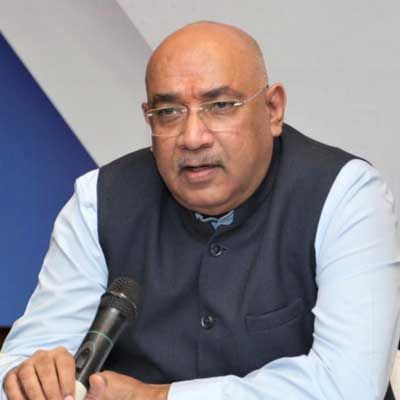- Home
- Real Estate
- Poised for Growth
Poised for Growth
The previous quarter of FY2016 registered the fastest GDP growth in the past five years at 7.9 per cent. This was largely driven by improving performances in the agriculture, mining and power sectors. Several other sectors also witnessed an annual growth rate higher than 7 per cent, including real estate services (categorised alongside financial, insurance and professional services), which registered the highest growth of 10.3 per cent. Inflation was a bit of a dampener as it continued to rise on a monthly basis, reaching 5.76 per cent in May 2016 over 5.41 per cent in April, reducing the chances of a rate cut by the central bank in the coming months. According to industry sources, real estate sector growth is pegged at $180 billion by 2020 in India. A number of recent policy initiatives including Good and Services Tax (GST), RERA, FDI relaxation, etc, are providing a positive environment for the growth, not just of the real estate industry, but the overall Indian economy. The government is proactively working with industry stakeholders to address development bottlenecks to help bring confidence back into the real estate market in India.
Sustainable development of any sector requires a balanced regulatory framework and healthy financing environment. Over the past year, the government has announced a number of initiatives, aimed at lifting the overall investor and consumer sentiment in the county. The Real Estate Regulatory and Development Act (2016) is a step in this direction. If implemented correctly, it will be instrumental in bringing back the confidence among investors. This legislation will not only regulate the sector, but will also promote transparency in the segment. In 2015, the government also adopted amendments to the Companies Act that eliminated the minimum capital requirement of Rs 100,000 in order to start a limited liability company in India.
Fund inflows
Other recent developments include the simplification of FDI policy for sectors such as food products manufacturing, defence and civil aviation, broadcasting, pharma, single brand retail trading, etc. These measures, among others, have helped in improving the country´s ranking in the ´Ease of Doing Business´ report published by the World Bank to 130 during 2015, from 142 during the previous year. In addition, the country´s demographic dividend continues to entice investments from foreign companies to establish their manufacturing base in the country.
Along with an improvement in investment flow, consumption is anticipated to improve in the coming months in both urban and rural areas, due to slowing inflation. The recent 24 per cent wage hike for civil servants is also likely to provide an impetus to consumption in the near future. Apart from structural reforms, improving private sector investments and rising consumerism, the on-ground implementation of the recently passed GST will be a game-changer for the Indian economy.
However, it is as important to look at the various issues that are impacting our growth story. With rapid development and economic growth, the stress on the existing infrastructure has increased significantly. Despite having gained significant momentum over the last few years, the infrastructure sector has been facing challenges because of indecisive policy or stringent regulatory framework, environment clearances (and related issues), financing concerns, etc. Recognising this, the government allocated Rs 55.7 lakh crore ($1 trillion) for infrastructure spending in the Twelfth Five-Year Plan. Almost half of this investment is expected from the private sector, with the government encouraging public-private participation models of infrastructure investment. In addition, most cities are plagued with lack of collaboration between various government agencies or departments within the urban areas. Any project undertaken by the Urban Local Bodies (ULBs), for facility upgradation or any other purpose, is not in sync with the other agencies in that area.
Capital issues
The real estate sector plays a key role in national development, and its sustained growth requires increased synergy between the various stakeholders, from the private players to government bodies. The lack of sufficient capital continues to be an area of concern for the sector at large, and needs to be addressed by the industry for sustained growth.
The policy framework has seen significant improvements and is better equipped to support the sector in the form of proposed changes in land acquisition laws, setting up of the real estate regulation and development authority (RERA), easing up of FDI norms in construction and framing Real Estate Investment Trust (REIT) guidelines. However, the processes need to be further simplified, with emphasis placed on single-window clearances to ensure timely completion of projects.
While the government has taken a lot of initiatives in this direction, a lot still remains to be done to boost the economy and the sector. While developers need to ensure timely execution of projects and building a portfolio of quality assets, lending institutes need to provide the adequate support. On its part, the government needs to work towards facilitating effective and timely implementation of the proposed initiatives in order for the industry to grow.
About the author:
Anshuman Magazine is Chairman,
India and South East Asia at CBRE. He is responsible for 29 offices (including affiliates) and over 10,000 employees across the region. With over 22 years at CBRE, he has pioneered the entry of professional real estate consulting services in India.
Although the policy environment remains conducive to growth, lack of sufficient capital continues to be an area of concern for the real estate sector at large, says ANSHUMAN MAGAZINE. The previous quarter of FY2016 registered the fastest GDP growth in the past five years at 7.9 per cent. This was largely driven by improving performances in the agriculture, mining and power sectors. Several other sectors also witnessed an annual growth rate higher than 7 per cent, including real estate services (categorised alongside financial, insurance and professional services), which registered the highest growth of 10.3 per cent. Inflation was a bit of a dampener as it continued to rise on a monthly basis, reaching 5.76 per cent in May 2016 over 5.41 per cent in April, reducing the chances of a rate cut by the central bank in the coming months. According to industry sources, real estate sector growth is pegged at $180 billion by 2020 in India. A number of recent policy initiatives including Good and Services Tax (GST), RERA, FDI relaxation, etc, are providing a positive environment for the growth, not just of the real estate industry, but the overall Indian economy. The government is proactively working with industry stakeholders to address development bottlenecks to help bring confidence back into the real estate market in India. Sustainable development of any sector requires a balanced regulatory framework and healthy financing environment. Over the past year, the government has announced a number of initiatives, aimed at lifting the overall investor and consumer sentiment in the county. The Real Estate Regulatory and Development Act (2016) is a step in this direction. If implemented correctly, it will be instrumental in bringing back the confidence among investors. This legislation will not only regulate the sector, but will also promote transparency in the segment. In 2015, the government also adopted amendments to the Companies Act that eliminated the minimum capital requirement of Rs 100,000 in order to start a limited liability company in India. Fund inflows Other recent developments include the simplification of FDI policy for sectors such as food products manufacturing, defence and civil aviation, broadcasting, pharma, single brand retail trading, etc. These measures, among others, have helped in improving the country´s ranking in the ´Ease of Doing Business´ report published by the World Bank to 130 during 2015, from 142 during the previous year. In addition, the country´s demographic dividend continues to entice investments from foreign companies to establish their manufacturing base in the country. Along with an improvement in investment flow, consumption is anticipated to improve in the coming months in both urban and rural areas, due to slowing inflation. The recent 24 per cent wage hike for civil servants is also likely to provide an impetus to consumption in the near future. Apart from structural reforms, improving private sector investments and rising consumerism, the on-ground implementation of the recently passed GST will be a game-changer for the Indian economy. However, it is as important to look at the various issues that are impacting our growth story. With rapid development and economic growth, the stress on the existing infrastructure has increased significantly. Despite having gained significant momentum over the last few years, the infrastructure sector has been facing challenges because of indecisive policy or stringent regulatory framework, environment clearances (and related issues), financing concerns, etc. Recognising this, the government allocated Rs 55.7 lakh crore ($1 trillion) for infrastructure spending in the Twelfth Five-Year Plan. Almost half of this investment is expected from the private sector, with the government encouraging public-private participation models of infrastructure investment. In addition, most cities are plagued with lack of collaboration between various government agencies or departments within the urban areas. Any project undertaken by the Urban Local Bodies (ULBs), for facility upgradation or any other purpose, is not in sync with the other agencies in that area. Capital issues The real estate sector plays a key role in national development, and its sustained growth requires increased synergy between the various stakeholders, from the private players to government bodies. The lack of sufficient capital continues to be an area of concern for the sector at large, and needs to be addressed by the industry for sustained growth. The policy framework has seen significant improvements and is better equipped to support the sector in the form of proposed changes in land acquisition laws, setting up of the real estate regulation and development authority (RERA), easing up of FDI norms in construction and framing Real Estate Investment Trust (REIT) guidelines. However, the processes need to be further simplified, with emphasis placed on single-window clearances to ensure timely completion of projects. While the government has taken a lot of initiatives in this direction, a lot still remains to be done to boost the economy and the sector. While developers need to ensure timely execution of projects and building a portfolio of quality assets, lending institutes need to provide the adequate support. On its part, the government needs to work towards facilitating effective and timely implementation of the proposed initiatives in order for the industry to grow. About the author: Anshuman Magazine is Chairman, India and South East Asia at CBRE. He is responsible for 29 offices (including affiliates) and over 10,000 employees across the region. With over 22 years at CBRE, he has pioneered the entry of professional real estate consulting services in India.
























